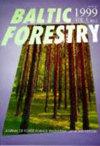应用人工神经网络预测热密实木单板的光泽度
IF 0.6
4区 农林科学
Q3 FORESTRY
引用次数: 0
摘要
本研究建立了人工神经网络(ANN)模型来预测热密实木单板的光泽度。采用MATLAB代码创建的自定义应用程序开发多层前馈神经网络模型。将木材种类、温度、压力、测量方向和入射角作为模型输入,而光泽度作为人工神经网络模型的输出。通过平均绝对百分比误差(MAPE)、均方根误差(RMSE)和决定系数(R²)来评估模型的性能。观察到,人工神经网络模型在可接受的偏差范围内产生了非常令人满意的结果。人工神经网络模型检验周期的MAPE、RMSE和R2值分别为8.556%、1.245和0.9814。因此,该研究可以为木材工业提供较少疲劳实验活动的光泽度预测。本文章由计算机程序翻译,如有差异,请以英文原文为准。
The Use of an Artificial Neural Network for Predicting the Gloss of Thermally Densified Wood Veneers
In this study, an artificial neural network (ANN) model was developed to predict the gloss of thermally densified wood veneers. A custom application created with MATLAB codes was employed for the development of the multilayer feed-forward ANN model. The wood species, temperature, pressure, measurement direction, and angle of incidence were considered as the model inputs, while the gloss was the output of the ANN model. Model performance was evaluated by using the mean absolute percentage error (MAPE), the root mean square error (RMSE), and the coefficient of determination (R²). It was observed that the ANN model yielded very satisfactory results with acceptable deviations. The MAPE, RMSE, and R2 values of the testing period of the ANN model were found as 8.556%, 1.245, and 0.9814, respectively. Consequently, this study could be useful for the wood industry to predict the gloss with less number of tiring experimental activities.
求助全文
通过发布文献求助,成功后即可免费获取论文全文。
去求助
来源期刊

Baltic Forestry
农林科学-林学
CiteScore
1.60
自引率
0.00%
发文量
23
审稿时长
>12 weeks
期刊介绍:
The journal welcomes the original articles as well as short reports, review papers on forestry and forest science throughout the Baltic Sea region and elsewhere in the area of boreal and temperate forests. The Baltic Sea region is rather unique through its intrinsic environment and distinguished geographical and social conditions. A temperate climate, transitional and continental, has influenced formation of the mixed coniferous and deciduous stands of high productivity and biological diversity. The forest science has been affected by the ideas from both the East and West.
In 1995, Forest Research Institutes and Universities from Estonia, Latvia and Lithuania
joined their efforts to publish BALTIC FORESTRY.
 求助内容:
求助内容: 应助结果提醒方式:
应助结果提醒方式:


